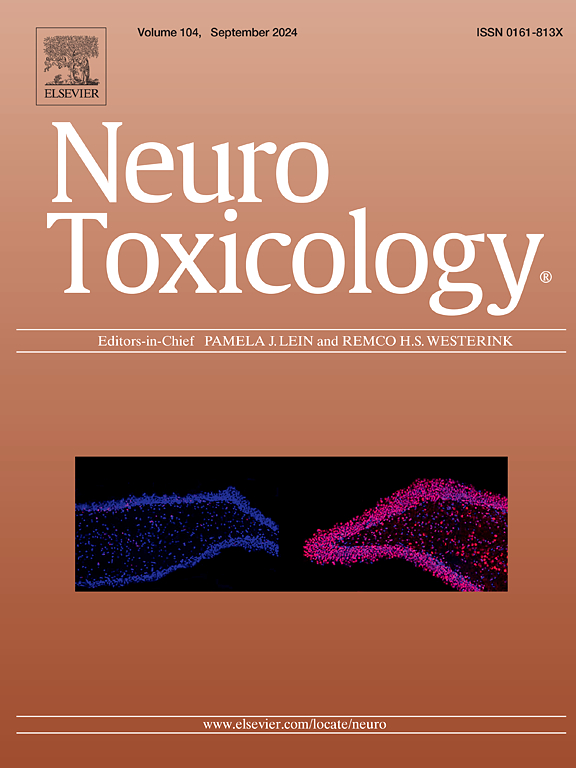他莫昔芬诱导多巴胺能rest缺失雄性小鼠对锰毒性的部分神经保护。
IF 3.9
3区 医学
Q2 NEUROSCIENCES
引用次数: 0
摘要
慢性锰(Mn)暴露会导致锰中毒,这是一种具有帕金森病(PD)样症状的神经系统疾病。选择性雌激素受体调节剂(SERM)他莫昔芬(TX)和re1沉默转录因子(REST)均显示出对Mn神经毒性的神经保护作用。由于TX通过Wnt信号传导增加REST并在体外保护多巴胺能(DAergic)神经元免受Mn毒性的影响,我们研究了在Mn暴露的雄性小鼠中,DAergic REST是否对TX诱导的神经保护至关重要,其中Wnt可能参与其中。在Mn (330μg MnCl 2,通过鼻腔滴注)暴露前,将TX颗粒植入野生型(WT)和DAergic REST敲除型(REST cKO)雄性小鼠3周,然后进行行为和分子分析。研究结果显示,TX减轻了mn诱导的WT小鼠运动和认知障碍,而REST cKO小鼠的这些影响则减弱了。能神经末梢所在的纹状体中的蛋白质水平表明,TX减弱了Mn诱导的WT中酪氨酸羟化酶和REST蛋白的减少,以及Mn的神经毒性,而这些对REST cKO小鼠的某些蛋白的保护作用减弱。Mn通过失调WT和REST cKO小鼠的Wnt3a和β-catenin蛋白来破坏Wnt信号传导。TX在WT中减弱了这些Mn效应,而在REST cKO小鼠中减弱较小,这表明有能量的REST有助于TX的wnt介导的Mn毒性神经保护。这些发现表明,在缺乏DAergic REST的情况下,TX对mn诱导的毒性和Wnt信号中断具有部分保护作用,但在雄性小鼠中,TX诱导的完全神经保护需要DAergic REST。本文章由计算机程序翻译,如有差异,请以英文原文为准。
Tamoxifen induces partial neuroprotection against manganese toxicity in the dopaminergic REST-deleted male mice
Chronic manganese (Mn) exposure leads to manganism, a neurological disorder with Parkinson’s disease (PD)-like symptoms. Tamoxifen (TX), a selective estrogen receptor modulator (SERM), and the RE1-silencing transcription factor (REST) have both shown neuroprotective effects against Mn neurotoxicity. Since TX, via Wnt signaling, increases REST and protects dopaminergic (DAergic) neurons against Mn toxicity in vitro, we investigated if DAergic REST is essential for TX-induced neuroprotection, with a potential involvement of Wnt, in Mn-exposed male mice. TX pellets were implanted in wild-type (WT) and DAergic REST knockout (REST cKO) male mice prior to Mn exposure (330 μg MnCl₂, via nostril instillation) for 3 weeks, followed by behavioral and molecular analyses. The findings revealed that TX attenuated Mn-induced impairments of movement and cognition in WT mice, while those effects were diminished in REST cKO mice. The protein levels in the striatum, where DAergic nerve terminals were situated, showed that TX attenuated Mn-induced reductions in tyrosine hydroxylase and REST proteins, as well as Mn’s neurotoxicity in WT, while these protections on certain proteins were diminished in REST cKO mice. Mn impaired Wnt signaling by dysregulating Wnt3a and β-catenin proteins in WT and REST cKO mice. TX attenuated these Mn effects in WT, with less attenuation in REST cKO mice, suggesting that DAergic REST contributes to TX’s Wnt-mediated neuroprotection against Mn toxicity. These findings demonstrate that TX induces partial protection against Mn-induced toxicity and Wnt signaling disruption in the absence of DAergic REST, but DAergic REST is required for TX-induced full neuroprotection in male mice.
求助全文
通过发布文献求助,成功后即可免费获取论文全文。
去求助
来源期刊

Neurotoxicology
医学-毒理学
CiteScore
6.80
自引率
5.90%
发文量
161
审稿时长
70 days
期刊介绍:
NeuroToxicology specializes in publishing the best peer-reviewed original research papers dealing with the effects of toxic substances on the nervous system of humans and experimental animals of all ages. The Journal emphasizes papers dealing with the neurotoxic effects of environmentally significant chemical hazards, manufactured drugs and naturally occurring compounds.
 求助内容:
求助内容: 应助结果提醒方式:
应助结果提醒方式:


